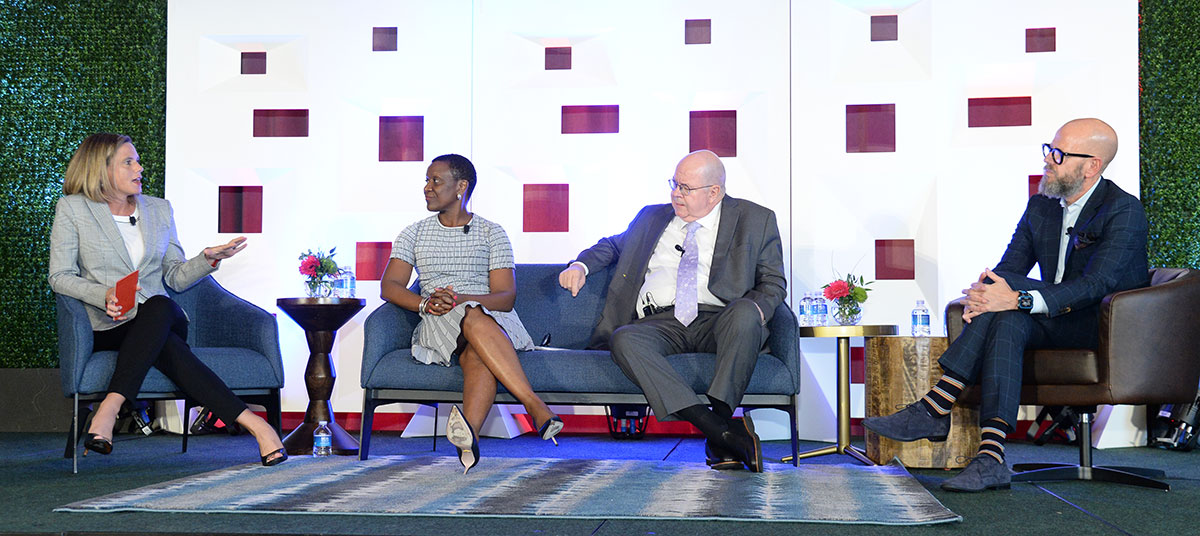
At CEIR Predict in October, a slate of expert speakers from outside of the events business took the stage to present insights about the latest social, consumer, economic and political trends shaping the world around us. Event organizers took note—copious notes, actually—about how to market their events in the face of rapid disruption as well as how events must adapt to deliver personalized, memorable experiences.
The health of the exhibition industry
Before diving into the latest consumer trends, CEIR’s own Nancy Drapeau, vice president of research, provided a wellness outlook of the overall exhibition industry. “Last year was a point where we finally left a recovery phase from the economic collapse of 2008,” said Drapeau. “We’ve passed the last high peak of performance and we’re in expansion mode, which is exciting.” But while news of growth is always positive, our expansion remains modest. “For 2019, it’s anticipated our growth is going to continue at a clip of 1.2%. It’s going to slow as the economy slows to 1.1% next year and then go to an estimated rate of 0.8% in 2021,” continued Drapeau. This growth rate means that events marketing will be a driving force in strategy decisions for the coming year to maintain and possibly increase our humble momentum—and event marketing is experiencing major shifts of its own.
Finding your tribe
Now more than ever, personalization is the name of the game. Going far beyond the Amazon culture of individualized interest, audiences and prospects increasingly want products and experiences that are tailored not just to their demographic, but specifically to them. John Gerzema, CEO of Harris Insights & Analytics/The Harris Poll, calls this “iDNA” one of the many trends emerging from recent research conducted by The Harris Poll. More and more, companies are tapping into this level of hyper-personalization. Diets can be based on blood type, supplements are tailored based on lifestyle and even music playlists can be created based on DNA. While event marketers aren’t collecting DNA samples as attendees walk through the door, they still have a unique opportunity capitalize on this growing desire.
Prospects and buyers want intimacy in a way that’s causing them to embrace a sense of “tribalism”—finding connections with one another based on common behaviors and interests. No longer can we place our target audiences in neat boxes without recognizing that people can be contradictory and that they are hungry to connect with others like them. This is particularly important in underrepresented groups, including Americans of color and women. “Regarding bringing in underrepresented groups into the conversation, that’s not a new trend, but it’s how we’re approaching it,” said panelist Michelle Mason, president and CEO of Association Forum, in response to Gerzema’s presentation. “We now need to learn and understand more about them. It’s not just a survey anymore, it’s getting into their environments and truly understanding their behaviors and what their needs are. … These underrepresented groups then find a sense of community within a bigger community. With tribalism, [it’s] ‘get to know me, understand who I am,’ and so I do believe it has a strong economic impact to the bottom line, but we just need to be more strategic about it.”
Navigating the generational divide
Generation Z and Millennials are two other groups who want their voices to be heard, yet they don’t want to be sold to. As the Millennial generation continues to occupy higher leadership positions, and as Gen Zers become active professionals, we have to incorporate them into our marketing plans—not just as an audience, but as a contributor. “Young people want access,” said Gerzema. “A big trend right now in business is ‘design thinking.’ Are we as an industry bringing younger people to do the design thinking on events? … What kind of events would they create?”
Recent behavior trends aren’t just affecting younger generations, either: Baby Boomers and Generation Xers are remaining in the workforce longer and have started to go back to school, giving event marketers a huge opening to highlight training and new skills opportunities.
Creating a can’t-miss experience
So, how do we leverage these behaviors across our target audiences to drive attendance? Emphasize the human-to-human experience.
Whether in B2B or B2C, we are still connecting with people. The Harris Poll named “short-selling” as one of their top consumer trends—essentially, getting what you want delivered to your door, and instantly. This presents the trade show industry with certain challenges, though they aren’t insurmountable. “The good news is, people like coming together and connecting,” added panelist Don Pazour, CEO of Access Intelligence. To overcome the need for instant, home-delivered gratification, we can provide value in our events by creating “snackable” content marketing pieces that engage our audiences year-round, allowing them to taste the experience before ever stepping foot onto the floor. “If you have [content] year-round, and you give those little bits and pieces and you allow little tribes to form, it can make the central event bigger,” said Pazour. “Either the people come and the show gets bigger, or you figure out how to monetize the bits.”
But even with year-round content, the tribes, the value and the experience blossom from human connection. That’s where trade shows still reign supreme. “It’s really about intimacy. There’s a lot of value in the larger event. … There’s a lot of value in the human connection in a smaller event as well,” said Mason. “We find that that’s our can’t-miss experience—when I can put you in the room with someone and you can connect with three quality people versus 30 individuals. That is something we need to be thinking more about.”
Event marketing is and always has been about connecting audiences. In order to be successful, however, we must remember that we are connecting to people—and these people crave belonging. By highlighting a personalized experience where attendees can ultimately find their tribe, we can continue to get the actions we want from our audiences.
*A version of this content originally appeared in PCMA Convene.


